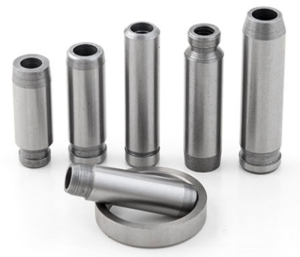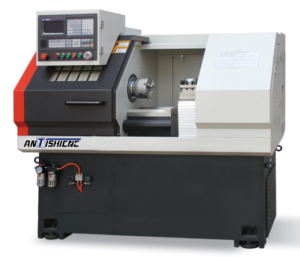ANTISHICNC CNC Turning Milling Machines,CNC Lathes
ANTISHICNC CNC Turning Milling Machines,CNC Lathes
The valve guide is an important component in the engine valve train, mainly used to ensure the normal operation of the valve and the good performance of the engine.
The shape of the valve guide is usually a slender tubular structure, with an inner diameter matching the diameter of the valve stem and an outer diameter matching the mounting hole on the cylinder head. The inner surface requires high finish and precision to ensure that the valve stem can reciprocate smoothly in it and reduce friction loss. The outer surface is generally smoother so that it can fit tightly with the mounting hole of the cylinder head.

Recently, Shanghai ANTS Machine Equipment Co., Ltd. successfully received an auto parts manufacturer from Saudi Arabia. The customer needed to purchase a CNC lathe to process the valve guide of the car, with a length of 30-50mm, an inner diameter of 12mm, and an outer diameter 2-5mm larger than the inner diameter.
Antis engineers successfully matched a CK6130 for the customer, with a maximum rotation diameter of 300mm and a maximum processing length of 230mm.
The following are the basic parameters of CK6130 CNC lathe:
| Basic parameters | Unit | CK6130 |
| Maximum turning diameter on the bed | mm | 300 |
| Maximum turning length | mm | 230 |
| X-axis track span | mm | 160 |
| Z-axis track span | mm | 240 |
| Tailstock sleeve diameter | mm | 52 |
| Spindle through hole diameter | mm | 48 |
Next, the engineers of ANTISHICNC will introduce you to the general process of automobile valve guide in detail:
(1) Preparation before processing
1.Familiar with the drawings: Carefully study the parts drawings of the valve guide to clarify its dimensional requirements, such as inner diameter, outer diameter, length, tolerance range, etc., as well as technical requirements such as surface roughness, form and position tolerance.
2.Select the blank: According to the material requirements of the valve guide, select the appropriate blank, generally seamless steel pipe or bar. Ensure the dimensional accuracy and surface quality of the blank to reduce processing allowance and improve processing efficiency.
3.Tool preparation: According to the processing technology and the material of the valve guide, select the appropriate tool. Commonly used tools include external turning tools, internal turning tools, cutting tools, etc. Carbide tools can be used to improve the wear resistance and cutting efficiency of the tool.
4.Fixture selection: Select a suitable fixture to clamp the blank. Commonly used fixtures include three-jaw chucks, four-jaw chucks, etc. For longer valve guide blanks, tailstock center auxiliary support can also be used to improve the stability and rigidity of the clamping.
5.Machine tool debugging: Check whether the performance indicators of the CNC lathe, such as spindle speed, feed speed, tool holder motion accuracy, etc., are normal. Enter machine tool parameters, such as tool compensation value, workpiece coordinate system, etc., to ensure that the machine tool is in good working condition.
(2) Processing process
1.Blank clamping: Use a fixture to clamp the blank on the CNC lathe. When clamping, pay attention to keep the axis of the blank coincident with the axis of the lathe spindle to ensure processing accuracy.
2.Rough machining:
Turn the outer circle: Use an outer circle turning tool to rough-machine the outer circle of the blank according to the programmed cutting parameters, remove most of the excess, close to the outer circle size of the valve guide, and leave an appropriate finishing allowance, generally 0.5-1mm.
Turn the inner hole: Replace the inner hole turning tool, drill and rough bore the inner hole of the blank, so that the inner hole diameter is close to the final size, and also leave a finishing allowance of 0.3-0.5mm.
3.Finishing:
Fine turning of the outer circle: Reduce the cutting parameters and use a sharp outer circle turning tool to fine turn the outer circle of the valve guide to ensure the dimensional accuracy and surface roughness of the outer circle.
Fine turning of the inner hole: Use an inner hole finishing tool to fine turn the inner hole of the valve guide to ensure that the diameter tolerance, cylindricity and surface roughness of the inner hole meet the requirements of the drawing.
4.Cutting: After processing, use a cutting tool to cut the valve guide from the blank. When cutting, pay attention to controlling the cutting speed and feed rate to avoid burrs or deformation on the cut surface.
(3) Post-processing
1.Quality inspection: Use measuring tools such as calipers, micrometers, inner diameter gauges, etc. to inspect the various dimensions of the valve guide to ensure that the dimensional deviation is within the tolerance range. At the same time, check the surface quality of the valve guide to see if there are defects such as knife marks, scratches, burrs, etc.
2.Deburring and cleaning: Remove burrs on the surface and orifice of the valve guide by sandpaper polishing, grinding, etc. Then clean the valve guide to remove impurities such as oil and iron filings left over from the processing process to ensure its cleanliness.
Labeling and packaging: Mark the part number, specifications and other information on the valve guide for easy identification and management. Finally, package the qualified valve guide to prevent damage during transportation and storage.

If you have any questions, please contact Shanghai Antis Machinery Equipment Co., Ltd. through our website information. Engineers will match you with efficient machine tools and professional services.
Keywords: CNC machine tools, CNC lathe, CNC vertical lathe processing valve guide